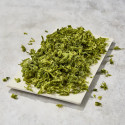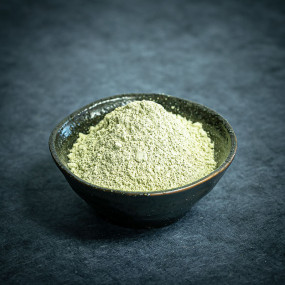Mie Prefecture is the leading producer of aosanori in Japan, with 60% of domestic production. This origin is the most prestigious in terms of quality and taste.
Aosanori prefers calm inland waters, making the rias coast of Mie prefecture an ideal place for its culture.
Another characteristic of Mie Prefecture's aosa is that its colour and taste vary according to where it is harvested. Every year, between January and April, the inhabitants call the coastal landscape of Mie prefecture "green carpet", making it a local seasonal feature. It is rich in minerals such as calcium, magnesium, lithium, vitamins and amino acids such as methionine.
The calm, nutrient-rich waters of Isewan Bay create the ideal conditions for the growing of the aosanori that thrives in these sheltered coastal areas. Nearby rivers, such as the Miyagawa (known for having the purest water in Japan) and the Kiso, enrich the waters with nutrients, while the warm Kuroshio current from the Pacific permeates the bay.
These ideal conditions of growth give the aosanori a deep color and a strong and vibrant taste and aroma. This seaweed is used as an ingredient in tsukudani, but it is also widely used for other uses, such as home and restaurant consumption, confectionery, and processed foods, such as instant miso soup.
Aosanori is very popular as a food for its fragrance rich in marine flavours and has long been used in many dishes, such as tempuras, light broth. In recent years, it is also used in everyday dishes such as Japanese pasta and omelettes. Aosanori is particularly well blended with crustacean soups and other dishes such as miso clam soup, crustacean pasta. It is also well known to accompany mushrooms and is often added to mushrooms soups. Aosanori algae are known for their strong lumami flavour. They marry well with rice, fries, sautéed noodles, okonomiyaki, steamed rice, mayonnaise, ramen. They are used to enhance the flavour of soups, broths and tempura paste or soy sauce. Like most algae, aosanori has this salty taste of the ocean.
What most people describe as such is actually a umami flavor. It is fresh and rich in iodine, with a slightly crisp texture in the mouth. It brings a touch of freshness to your dish while remaining subtle. Choosing Isewan's aosanori is the adoption of the ultra-highest Japanese chefs. Its thickness and flavors are unique. Each lot is subject to strict quality checks by the Aosanori Production and Distribution Committee of Mie Prefecture. A centralized collection system ensures complete traceability and quality control of products. Colours and flavours are unique and unique to each fishing area. The aosanori algae proposed here have benefited from exceptional growth for a more fleshy and consistent product.
They come from rigorous quality control and a complete inspection system with protected cultivation methods. Their traceability is complete: complete verification of origin, from harvest to marketing. All "Mie" certified Aosa algae must meet these stringent standards, guaranteeing a constant superior quality for each product.














































